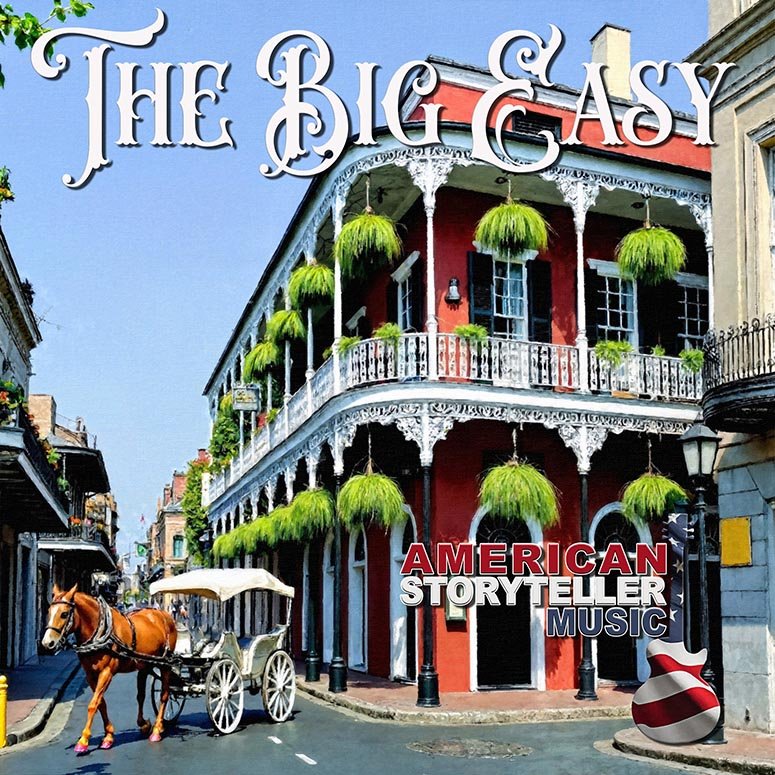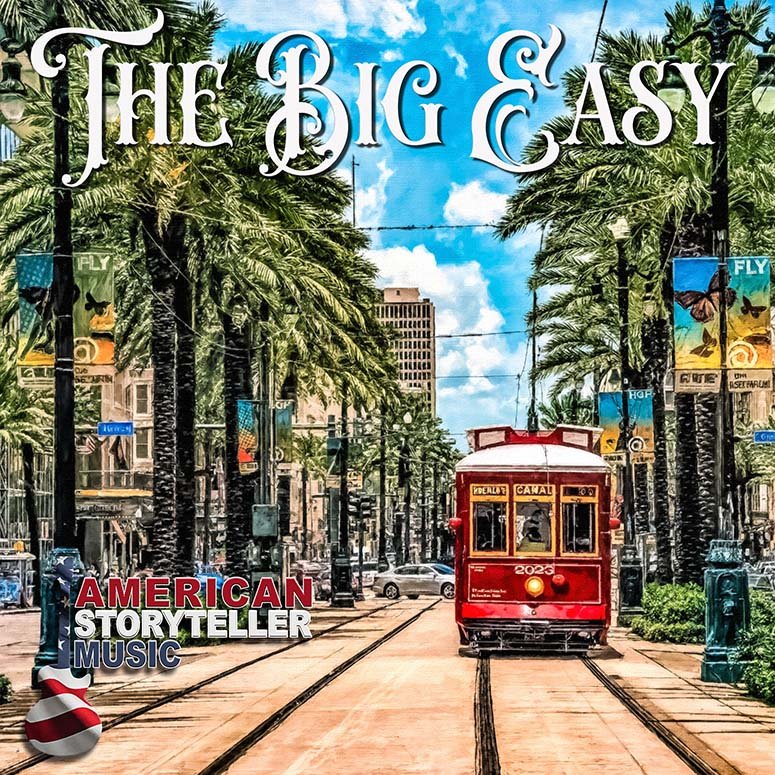"The Big Easy©"
Lyrics by M.S. McKenzie | Performed by American Storyteller Music & is Protected by Copyright


~ Associated State Links ~
State of LA Home Page | State of LA Gallery Page
"The Big Easy"
[Intro]
A heavy fog hangs low over Jackson Square's worn cobblestones
The scent of sweet ben·yayz fills the air with a flavor all their own
A lone sax plays a mournful plea, a jazzy rhythm so deep and true
Another night in ole New Orleans, another song played just for you
[Verse 1]
Gas lights paint the French Quarter with a soft and golden gleam
As he belts out an old forgotten tune echoing like a fading dream
His worn-out black, leather case sits empty upon the dirty stones
But in his heart, there’s a fire that you can feel deep in your bones
He plays for tourists and passersby—tossed coins catch the light
He plays for lovers and lost souls in the shadows of the night
[Chorus]
Oh, New Orleans, the City of Jazz, filled with a symphony of sounds
From Frenchmen Street to Royal's pass, there’s music too be found
A trumpet’s soulful echo or a saxophone's sad lament, a story unfolds
Of broken dreams and bitter loss through the allegories they have told
[Instrumental Breakdown]
[Verse 2]
The Mississippi winds its way through downtown and the French Quarters sites
The saxophonist plays a melancholy tune through these long and lonely nights
Where the ghosts of legends like Armstrong and Dr. John echo in the air
His instrument plays their haunted tunes, their burdens he seems to bear
He sees their faces in the crowds, still haunted by the specters of long ago
If you listen long enough, you’ll catch his drift as the music begins to flow
[Bridge]
But shadows lengthen, a sudden chill, a mournful trumpet cry
A ghostly wail echoes from the street, as a funeral procession passes by
The music falters, a whispered loss, a tear falls from his eye
Then, gathering strength, the melody shifts, a somber waltz in reply
[Verse 3]
Horse and carriage clip-clop softly by with a glint of magic in its eye
The heavy, sweet scents of corn and crayfish jambalaya wafts on by
He switches to a tune of hope and grace, a supplication upon the breeze
Suddenly, a smile lights up his face as he changes his tune with ease
Another musician then joins in with a smile and a trumpet upon his chin
Then a drummer and a bass join, playing “When the Saints go Marching in”
[Instrumental Breakdown]
[Verse 4]
The sax player started up again, but now he was the leader of the band
His new tune was low and deep, and could be felt throughout the land
The sad stories once etched upon his face—chased away by newfound joy
For now he had a purpose in life, playing ragtime jazz that was hard to avoid
During the sultry nights of summer this brand-new band performs
Bringing throngs to Conti and Decatur where dancing becomes the norm
[Chorus]
Oh, New Orleans, the City of Jazz, filled with a symphony of sounds
From Frenchmen Street to Royal's pass, there’s music too be found
A trumpet’s soulful echo or a saxophone's sad lament, a story unfolds
Of broken dreams and bitter loss through the allegories they have told
[Outro]
Dawn breaks over the Big Easy in pastel hues across the sky—Oh
[Final Chorus: backed by up-tempo, danceable jazz music]
Oh, New Orleans, the City of Jazz, filled with a symphony of sounds
From Frenchmen Street to Royal's pass, there’s music too be found
A trumpet’s soulful echo or a saxophone's sad lament, a story unfolds
Of broken dreams and bitter loss through the allegories they have told
[Outro: light, joyful, island jazz with sax, trumpets and steel drums]
Dawn breaks over the Big Easy in pastel hues across the sky—Oh so pretty
Monday begins with honking cars and streetcar sounds—rhythms of the city
But for those lucky few who heard that ragtime jazz and stomped their feet
Carry a melody in their hearts, whether they are bosses, bakers or walk a beat
They all know where the air is sweet and there’s dancing in the streets
[Instrumental Outro: ragtime jazz fades out]
Song Description
Style/Genre: Jazz ballad with ragtime and Dixieland influences
BPM Range: 85–145 BPM (tempo rises gradually from reflective ballad to celebratory street jazz)
Location: New Orleans, Louisiana
Theme: Perseverance through music, the spirit of New Orleans, community, and transformation through shared rhythm
Mood: Melancholic at first, shifting to hopeful, joyful, and celebratory
Description:
The Big Easy is a vivid and soulful journey through the heart of New Orleans, told through the story of a lone street musician whose saxophone echoes the city’s layered history. Beginning in the moody haze of dawn over Jackson Square, the intro sets the scene with fog-laced cobblestones and the familiar scent of beignets in the air. A solitary saxophone cries out a reflection of both solitude and the timeless soul of New Orleans.
The first verse immerses us in the French Quarter’s golden gaslight glow. Listeners are introduced to the saxophonist, whose weathered case and passion hint at a deeper story. Though coins are sparse, his music burns with emotional truth, capturing the attention of lovers, tourists, and night-drifting souls alike. The chorus expands this sentiment, painting the entire city as a living musical score from Frenchmen Street to Royal and conveying the power of jazz to tell stories of both heartbreak and resilience.
An instrumental breakdown provides a moment of reflection before verse two deepens the narrative, introducing the spirits of musical giants like Louis Armstrong and Dr. John, whose presence seems to haunt the streets and inspire the saxophonist's melancholic phrasing. As he plays, his music becomes a vessel for history and memory, blending past and present.
The bridge introduces a somber moment, a passing funeral procession, a ghostly trumpet cry, shifting the emotional tone to mournful introspection. But like New Orleans itself, the music adapts, waltzing through grief and transforming sorrow into something beautiful.
By verse three, the scene lightens. The smell of jambalaya drifts by, a horse-drawn carriage rolls past, and the saxophonist begins a tune of hope. Other musicians join him organically, building into a spontaneous street band. As they erupt into “When the Saints Go Marching In,” the city comes alive, and joy replaces solitude.
A second instrumental breakdown makes way for verse four, where the once-isolated musician is now the proud leader of a band. His sorrow has been replaced with purpose, and his sound, low, deep, and infectious, spreads through the summer nights, drawing crowds to the lively corners of Conti and Decatur.
The chorus returns, now charged with triumphant energy. The final chorus bursts forth with up-tempo, danceable jazz, lifting the mood into celebration. The outro paints a scene of dawn over the Big Easy, where Monday mornings carry the rhythms of a city forever steeped in music. The closing lines remind us that the beat lives on in everyone, regardless of who they are or where they go, because in New Orleans, music is not just performance; it’s identity.
The instrumental outro leaves listeners with the fading strains of ragtime jazz, as if walking away from an unforgettable night in the Quarter, where music spills from every doorway and dancing in the street is just a natural part of life.

